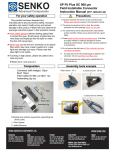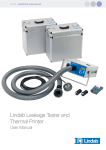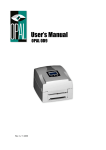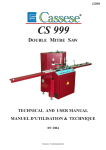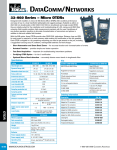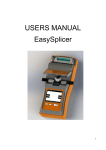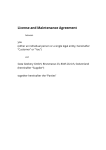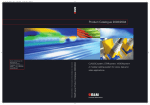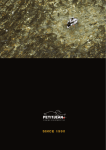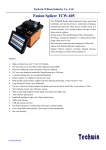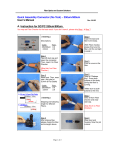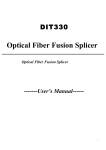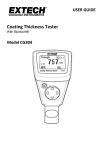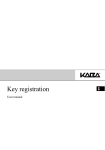Download FO Field RM-FAC-08
Transcript
FO Field RM-FAC-08 01.07.2014 / V1.0 / Dei – – – – – – – – Reduced back reflection ≥ 60dB Easy to use, no training required Multi-position diamond blade > 10’000 cleaves (10x1’000) Angled cleaving of 125µm fiber Average end angle of 8 degrees (+/- 1 degrees) Mirror smooth end faces , no hackle Minimal glass roll-off Easy to use with "stapler" action Specifications Fiber diameter 125µm fiber Cleave and angle Preset cleave length 8° average 1° standard deviation > 10mm for 250µm – 900µm Blade life >10’000 cleaves (10 positions with min. 1’000 cleaves) Dimension 78 x 62 x 48mm Weight 220g Angle variation over core 1° (1-sigma) Glass roll-off ≤ 40µm Content Specifications .............................................................................................................. 1 Issue & Scope ............................................................................................................. 2 Introduction ................................................................................................................. 2 Contents of Cleaving Kit & Unpacking ........................................................................ 2 Using the Cleaver ....................................................................................................... 2 Description of RM-FAC-08 Cleaver ............................................................................. 4 This document was prepared with the greatest possible care and reflects the current state of technology at the time of printing. Subject to corrections and technical changes. Issue & Scope This datasheet will be updated from time-to-time to reflect technical changes to the product. It covers the basic information’s of the RM-FAC-08 (FAC=Field Angled Cleaver) precision optical fiber cleaver. More detailed information’s can be found in the user manual delivered with the product. Introduction The RM-FAC-08 Field Angled Cleaver is designed to cleave a single 125µm diameter single mode optical fiber with a mirror-smooth, damage-free end with the core angled at 8º (±1º) from the perpendicular. Cleaving a single mode fiber at around 8º from the perpendicular ensures the back-reflection will not be guided down the fiber, and hence the return loss will be around 60dB (reflectance of -60dB or greater). 8° angled cleaves are used in mechanical splices to form a mechanical join for instance in FTTx applications. The cleaver can be used as a field tool or on the bench top. The fiber is fixed in to a fiber holder. The stripped fiber passes between two dowels on the offcut side. The cleave is carried out by pressing down the anvil. The two vertical O-rings trap and clamp the fiber, the anvil deflects the fiber to a stop and the tensioned fiber is lowered on to the diamond blade to cleave the fiber. The offcut is left between the dowels. Remove the offcut and dispose of carefully Contents of Cleaving Kit & Unpacking The cleaver is supplied along with the following items: 1. User Manual: folded sheet 2. Fiber adapter for 900µm coated fiber (fitted to cleaver) 3. Fiber adapter for 2.1mm cabled fiber 4. Fiber adapter for 3.0mm cabled fiber 5. Carrying bag Using the Cleaver 1. Fiber Preparation Place fiber in fiber holder. Strip back primary, secondary and outer coatings, as required. Clean fiber thoroughly using a lint-free wipe wetted with alcohol (IPA) The bare fiber should be at least 35 mm long to ensure that the glass cladding passes over the hole in the reference plane and through the dowels forming the fiber location channel on the offcut side of the hole and over the edge of the cleaving plane for easy offcut extraction. Page: 2 www.rdm.com 2. Fiber insertion and setting cleave length Insert fiber and align to the correct cleave length (minimum = 10mm) and close the magnetic lids - 900µm fiber adapter: pass coating between 2 pairs of guidance posts and align end of coating (see below) - 2.1mm or 3.0mm cable adapters: clamp cable in to adapter with magnetic lid. 900µm coating passes between 2 pairs of guidance posts (see below) Reichle & De-Massari AG Binzstrasse 32 CHE – 8620 Wetzikon Telephone HQ: +41 (0)44 933 81 11 Telefax HQ: +41 (0)44 930 49 41 Tip: Rotate the fiber tube so that the fiber curls downwards towards the clamping planes. Avoid upward curl because this makes the fiber difficult to pass throught the dowel channels. Avoid sideways curl because the fiber is not straight across the cleaving and might miss the clamping ridges. The stripped end of the fiber passes across the hole in the clamping plane and through the pair of dowels on the offcut side of the tool. 3. Cleaving the Fiber The fiber is cleaved by pressing down the anvil. The vertical O-rings trap and clamp the fiber. The anvil deflects the fiber by a fixed amount The cleaving plane, carrying the clamped and tensioned fiber moves downwards so that the fiber strikes the diamond blade, cleaving the fiber. After cleaving, release the anvil and open the tool 4. Remove Cleaved Fiber Remove the cleaved fiber by opening the magnetic lid Take care that the cleaved fiber end does not touch the tool surface as this may cause dirt to attach to the cleaved end face. 5. Remove Fiber Off-Cut The offcut is left between the dowels after cleaving. Remove the offcut and dispose of carefully. Please Note: The cleaver may not work properly if the offcut from previous cleaves remains in the tool The fiber off-cut is a sharp hazard. Dispose of safely. The tool is ready to cleave the next fiber. 6. Cleaving Problems Offcut fiber in channel. Remove with finger or by turning tool on side and shaking out. Dispose of offcut Offcut fiber in other part of tool. Remove using wipe or finger. Dispose of offcut Will not cleave. Blade damaged - advance blade by turning end screw clockwise by 1 full turn. Measuring End Angle: It is not possible to measure the end angle from a side projection (e.g. in a fusion splicer). The angle can be measured from the cleaved surface using surface profiler or interference technique. Blade damage: A large chip is seen in the cleaved end face. advance blade by turning end screw clockwise by 1 full turn. Excess hackle or poor surface quality: cleave is usable if core of fiber end face is smooth. High back-reflection: Cleaver and/or fiber are dirty. With dirt back-reflection is increasing. Thoroughly clean tool. This document was prepared with the greatest possible care and reflects the current state of technology at the time of printing. Subject to corrections and technical changes. Description of RM-FAC-08 Cleaver Fiber/tube holder Clamping-plane Fiber positioner Anvil O-rings Diamond blade Blade advance screw Page: 4 www.rdm.com Reichle & De-Massari AG Binzstrasse 32 CHE – 8620 Wetzikon Telephone HQ: +41 (0)44 933 81 11 Telefax HQ: +41 (0)44 930 49 41




